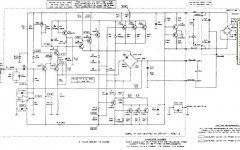One comment was to add a "dominant pole capacitor" to remove the oscillations. I have no idea where this might be added into the circuit ?
The 606 is a "current dumping" amplifier, similar to the original 405. Thermal stability is inherent, but frequency stability is another matter.
It's not a normal feedback circuit by any means: here's the original Wireless World article, which explains everything in great detail:
http://www.keith-snook.info/wireles...d-1975/Current Dumping Audio Amplifer DCD.pdf
And these may be of interest too:
http://www.keith-snook.info/wireles...Current dumping - does it really work DCD.pdf
Quad 405-2 upgrades
Key features are: the current dumper transistors operate as a crude class-B output stage (zero standing current); an agile, low-power, class A output stage contributes current as required to minimise crossover distortion, all via a C/L/R/R bridge. More feedforward than feedback, really.
Anyway, this sounds pretty tricky. I wonder if the oscillation is caused by the emitter-follower dumpers self-oscillating? You could always try adding base stopper resistors, close to the transistors.
Good luck!
It's not a normal feedback circuit by any means: here's the original Wireless World article, which explains everything in great detail:
http://www.keith-snook.info/wireles...d-1975/Current Dumping Audio Amplifer DCD.pdf
And these may be of interest too:
http://www.keith-snook.info/wireles...Current dumping - does it really work DCD.pdf
Quad 405-2 upgrades
Key features are: the current dumper transistors operate as a crude class-B output stage (zero standing current); an agile, low-power, class A output stage contributes current as required to minimise crossover distortion, all via a C/L/R/R bridge. More feedforward than feedback, really.
Anyway, this sounds pretty tricky. I wonder if the oscillation is caused by the emitter-follower dumpers self-oscillating? You could always try adding base stopper resistors, close to the transistors.
Good luck!
Damn, those links aren't working. Try pasting these into your browser url box:
add "http://www." as a prefix
keith-snook.info/wireless-world-magazine/Wireless-World-1975/Current%20Dumping%20Audio%20Amplifer%20DCD.pdf
keith-snook.info/wireless-world-magazine/Wireless-World-1978/Current%20dumping%20-%20does%20it%20really%20work%20DCD.pdf
add "http://www." as a prefix
keith-snook.info/wireless-world-magazine/Wireless-World-1975/Current%20Dumping%20Audio%20Amplifer%20DCD.pdf
keith-snook.info/wireless-world-magazine/Wireless-World-1978/Current%20dumping%20-%20does%20it%20really%20work%20DCD.pdf
Tell us a bit about the oscillating one.
1. What frequency?
2. does it change with/without speaker
3. Does the oscillation change with output current?
4. What does the oscillation wave-shape look like?
1. What frequency?
2. does it change with/without speaker
3. Does the oscillation change with output current?
4. What does the oscillation wave-shape look like?
Hi,A while ago I built a Quad 606 clone using MJ15003 output transistors. One channel works perfectly but the other channel oscillates.
One possibility is that the choice of output transistors might be the cause of the problem.
I am trying to build a 606 clone using Chinese PCBs. It will only work on headphones but on speaker distorts considerably.
Transistors will vary considerably unit to unit. Was this built on a pcb?It's odd that one works perfectly and the other oscillates.
Yes - as shown. The oddest thing is that distortion increases with the more heat sinking I add.Transistors will vary considerably unit to unit. Was this built on a pcb?
Attachments
Oscillations will vary, depending on the capacitance added by the heat sink between the transistor and ground.
The isolation pad is the parasitic capacitor's dielectric. You may have to reduce the bandwidth earlier in the
circuit by forming a dominant pole there, to reduce HF phase shift enough for stability.
If you are not grounding the heat sink(s) at all, scrape off the heat sink finish in a spot, and add a ground wire.
In that case, this may very well fix the problem.
The isolation pad is the parasitic capacitor's dielectric. You may have to reduce the bandwidth earlier in the
circuit by forming a dominant pole there, to reduce HF phase shift enough for stability.
If you are not grounding the heat sink(s) at all, scrape off the heat sink finish in a spot, and add a ground wire.
In that case, this may very well fix the problem.
Last edited:
Did you find the cure for the oscillation?A while ago I built a Quad 606 clone using MJ15003 output transistors. One channel works perfectly but the other channel oscillates.
One possibility is that the choice of output transistors might be the cause of the problem.
The same thing happened to mine and the problem was cured by altering the value of R8 which governs the current in part of the circuit.
For what it's worth.... here is the Quad 606 from a friend of mine, and it developed some hum accompanied by hiss, on one channel.
Closer inspection showed the resistors in the output zobel network were grilled (R33), on the defective channel it did not measure 10 Ohms but 50 KOhms.... Judging by the color of the other channels' resistor, it was not far from giving up as well. They only lasted 30 odd years 😀
Replaced both, no more hum and hiss, playing happily !


Closer inspection showed the resistors in the output zobel network were grilled (R33), on the defective channel it did not measure 10 Ohms but 50 KOhms.... Judging by the color of the other channels' resistor, it was not far from giving up as well. They only lasted 30 odd years 😀
Replaced both, no more hum and hiss, playing happily !
- Home
- Amplifiers
- Solid State
- Quad 606 clone oscillating



